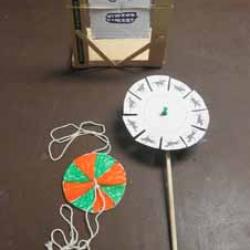Source Institutions
Source Institutions
Add to list Go to activity

In this activity, learners construct three optical illusion toys to examine how our brains play tricks on what we see. Learners use simple materials to build a Circle Spinner, Thaumatrope, and Phenakistascope. Each project can be completed individually or as a set. This lesson guide includes background information about how these toys produce optical illusions as well as an explanation of how TVs and movies work. [Activity is publicly available through a web crawler capture on Archive.org.]
- 5 to 10 minutes
- 30 to 45 minutes
- $1 - $5 per student
- Ages 6 - 18
- Activity, Lesson/Lesson Plan
- English
Quick Guide
Materials List (per student)
- Thin cardboard
- String - strong and thick
- White paper
- 1 Baseboard
- 1 Paint paddle
- 2 popsicle sticks
- Rubber bands, medium
- File Folder or thick paper
- 2in. 1x2 wood
- 8 in. dowel, 1/4 in.
- Patterns (page 8 of PDF or find your own online)
- Black paper
- Stapler
- Big cups for circle
- Markers
- Nail, small to balance Circle Spinner and poke holes
- Glue stick (not hot)
- Mirror
Subjects
-
Engineering and Technology
- Technology
-
Life Sciences
-
Human Body
- The Brain and Nervous System
-
Human Senses and Perception
- Vision
-
Human Body
-
Physical Sciences
- Vibration and Waves
- Motion and Forces
Informal Categories
- Arts and Crafts
- Photography and Film/Video
- Toys
Audience
To use this activity, learners need to:
- see
- see color
- touch
Learning styles supported:
- Involves hands-on or lab activities
Other
Includes alignment to state and/or national standards:
This resource is part of:
Access Rights:
- Free access
By:
- Watsonville Environmental Science Workshop
Rights:
- All rights reserved, Watsonville Environmental Science Workshop, 2011
